This was published 7 years ago
Bruce Armstrong's menagerie of metaphors descends on the NGV
By Ray Edgar
Down a Cremorne alley an abstract plaque on a bright red warehouse door heralds Bruce Armstrong's studio. Inside a telamon lies bound with rope. Saturn devours his children. Moulds of eagles await reincarnation. A weathered wooden temple thirsts for preserving oils. Experiments with torched portraits of cats stand propped and unfinished. Tools and axes rest on makeshift timber plinths. Burlap fabric and tarps conceal further objects.
"It's like an Egyptian tomb," enthuses curator David Hurlston. Except this tomb has already been ransacked – Hurlston its raider. The nabbed booty – 40 of Armstrong's mythic figures – is spread across three floors of the NGV Australia for a new survey show, An Anthology of Strange Creatures.
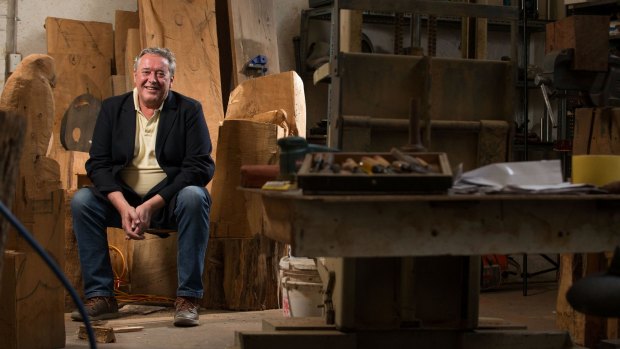
Artist and sculptor Bruce Armstrong.Credit: Darrian Traynor
Armstrong's work embraces the fantastical, the mythic, the folkloric and the fairytale. Gryphons, bears, heraldic figures, timber gargoyles, ancient cities on turtles are all conjured in mighty Australian timbers. Perhaps his grandest are in the ground floor entry to the gallery – the Guardians (1987). Carved from two offcuts of 400-year-old river red gum, the animated animals weigh 5.2 tonnes and 4.8 tonnes. For years they stood guard in front of the fortress-like NGV International.
As Ted Gott writes in the exhibition catalogue Armstrong uses the "vernacular to create the spectacular", offering a "homegrown response to the protective felines that have stood sentinel before bastions of culture and power for millennia, such as the ceramic lions guarding the Mesopotamian city of Babylon (c. 604–562 BCE) or George Frampton's stone lions (1909–14) outside the Edward VII entrance to the British Museum in London."
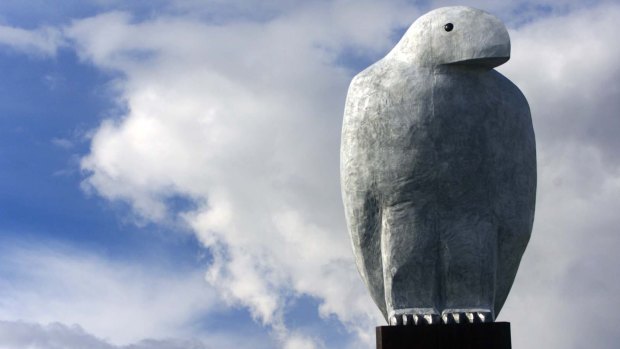
Armstrong's Eagle - a giant sculpture inspired by 'Bunjil' - overlooks Docklands.Credit: Paul Harris
Repositioned inside the Australian galleries, the Guardians announce the archaeological excavation of Armstrong's oeuvre from 1970 to 2016.
Tall and burly, not unlike his sculptures, Armstrong wields chainsaws and axes to carve his creations. True to his name Armstrong shifts these massive pieces of timber himself. "I just use crowbars and wedges, Egyptian style," he says. "You'd be surprised what you can move."
If Armstrong's subject matter draws on historic iconography, sculpting in stone has little appeal. "Stone sculptures from the past tend to be over refined in my view, and maybe a bit slick," he says. "I prefer a looser vision and things that go wrong – bits that are rotten, cracks - are part of the process of reacting with this material."
It's the intrinsic nature of timber that beguiles. "There's several hundred years of life that happened before it got to me," he reflects. "It's been drawing water out of ground and light from the sky and reacting in the wind and living and supporting other creatures and life forms. It's a very alive thing. I want it to be about that life it had before me and the life that it has after me as well."
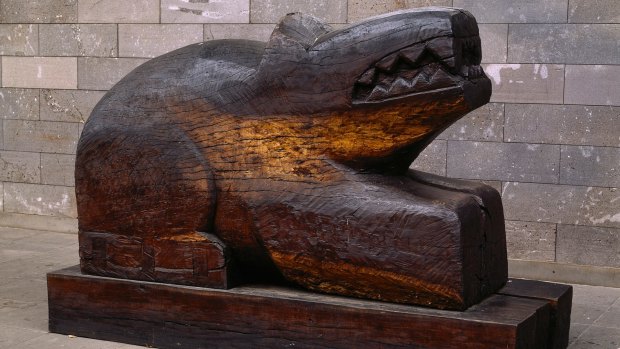
Guardians (1987) has pride of place on the ground floor entry of the National Gallery of Victoria.
For the 59-year-old artist the opportunity to look back on his own life's work is "like psychoanalysis", he says. "What I was going through all comes up to the surface. It's closing the loop and looking forward to the next stage."
Each floor of the gallery's foyer spaces loosely explores a theme: 'genesis', 'intimacy' and 'reconciliation'. Yet 'genesis' features a giant horizontal eagle sarcophagus, called Rest (2002-3), suggesting the loop doesn't close, but continues into the afterlife.
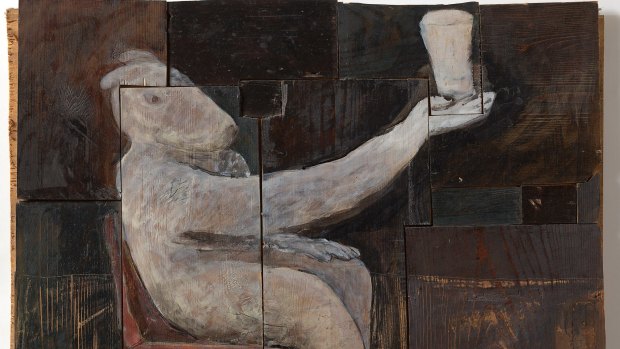
Welcome Home, 2001.
"I like dealing with thoughts about death, but in a positive way," he says. "Look at Egyptian sarcophagi, they're all bright colours. Death culture was a big part of what made life worth living. What you did during your life effected what you went through when you died. Your heart has to be as light as a feather. Osiris would weigh it."
Duality forms a recurring theme in Armstrong's works. One Guardian lion rests in repose, the other roars into life. For Armstrong duality is bound up in the notion of protection. "You can't have one without the other," he says. In Bete Noire (2012) a black beast grasps a white human figure. Yet while this might be a metaphor for depression, Armstrong doesn't see it as the enemy.
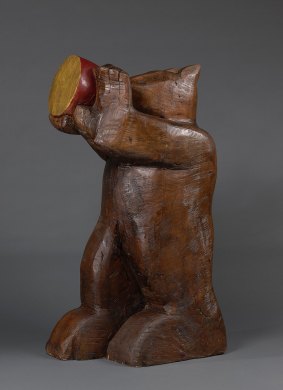
Speculum (or Bear), 2012.
"We all go through cycles of feeling down and up and that can be a force for good in a way," he says. "When you're up and you've been down you really like being up. A lot of good things happen. This was a reconciliation of the opposites of down and up, black and white, yin and yang. It's protective as much as anything else."
Among these figures are maquettes for his other well known public sculptures, the 23m tall Eagle (Bunjil) (2002) that watches over Docklands, and the two eagle Guardians (2009) outside the Grand Hyatt hotel's Russell Street entrance. In Self-portrait (2005), one of Armstrong's five Archibald entries, he depicts himself as a falconer.
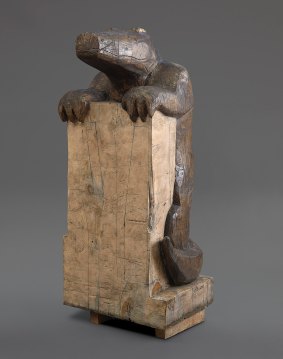
Crocodile, 2000.
Armstrong's preoccupation with animals and animist cultures - Egyptian, Hawaiian, aboriginal - stems from his own experience. "I've had various things happen in my life where strange and significant things have taken place and there's often an animal present and associated with a strong memory."
His menagerie of mythic and medieval characters are metaphors, he says. They represent psychological states rather than art-historical references. "It's not about bears talking to bears," he deadpans.
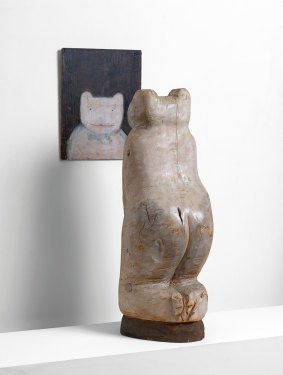
Bast,1990.
Nevertheless if isolating heraldic figures like a bear wearing a crown around its neck suggests the hubris of power, Armstrong says it's not his intention. "I'm not trying to debunk anything. I'm trying to enjoy myself making stuff. I tried to make a few works at times that felt like they had a social conscience."
And how did that go?
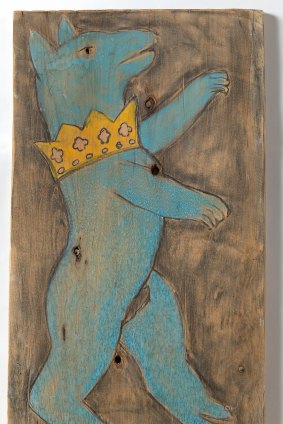
Herald, 2009.
"They're not here," he laughs. "You want to say everything, but you can't. I like the idea of it being open-ended enough that people can make wildly different things of what you're looking at."
Play remains important: "I do enjoy this work," says Armstrong. "To work for no money for 20 years you have to like it. Paul Klee said 'art is significant play'. It's not taking yourself too seriously but you should love being there and not all self-conscious about what people are going to make of what you've done."
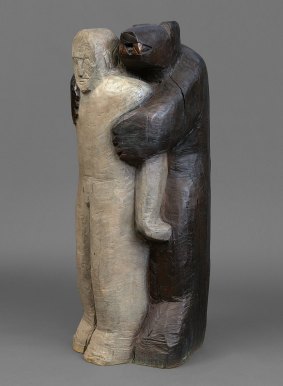
Bete Noir, 2012.
"I don't plan anything much. Where's the fun? You might as well be making furniture. If you knew what you were going to do at the beginning what would be the point? I like not knowing what's going to happen."
From the beginning Armstrong encouraged children to touch his sculptures. "If you're drawn to the sculpture at all your natural instinct is to touch it. Smell it, taste it, touch it As a result you've got this beautiful feel, like an old bannister," he says rubbing Tyger (1984).
Indeed he believes the natural oils from human hands has helped preserve Tyger and the NGV Guardians better than some of his other sculptures left to the elements.
Ultimately, of course, it's the hand of the artist that's preserved.
"There's an element of fearsomeness [to Armstrong's sculptures]," says Hurlston. "But there's something about Bruce's style. There's a warmth about them – like Bruce."
"And a little bit overweight," Armstrong quips.
Bruce Armstrong: An Anthology of Strange Creatures, NGV Australia, August 26, 2016–January 29, 2017; ngv.vic.gov.au